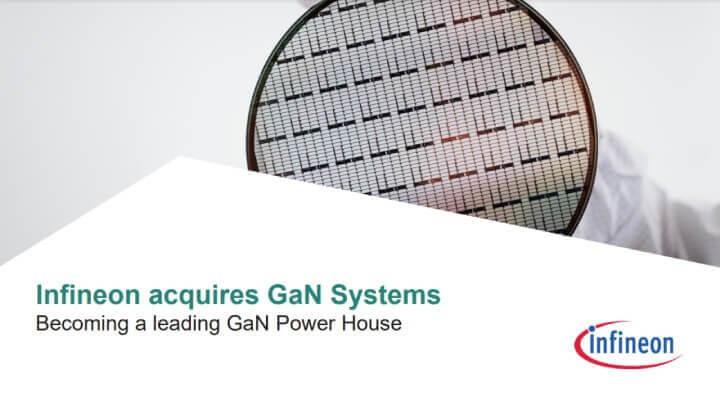Infineon Acquires GaN Systems: A Power Move in Semiconductors
14-03-2024 | By Gary Elinoff

Combining Strengths. Image source: Infineon
Key Takeaways from Infineon's Acquisition of GaN Systems:
- GaN Systems integrates into Infineon, expanding its technological prowess.
- Infineon enhances its portfolio, becoming a comprehensive provider of power semiconductors.
- The merger creates a robust manufacturing network, increasing resilience to market fluctuations.
Introduction
It’s been a hot topic for over a year, and now it’s official[1]. German semiconductor giant Infineon, with almost 60,000 employees, has acquired Canadian Gallium Nitride specialist GaN Systems at a cost of $830 million (US). Infineon already has a powerful presence in the worldwide market for GaN power semiconductors, as well as in Silicon Carbide (SiC) devices.
With the acquisition of GaN Systems, Infineon not only broadens its technological base but also enhances its strategic positioning in the rapidly evolving power semiconductor market. This move is a testament to Infineon's commitment to leading the transition towards more energy-efficient power solutions, a crucial step in addressing global energy challenges and climate change. The synergy between Infineon's extensive R&D capabilities and GaN Systems' innovative GaN technology promises to unlock new possibilities in power electronics, driving advancements in various sectors including renewable energy, automotive, and consumer electronics.
What the Principals Say
Jochen Hanebeck, CEO of Infineon, states that “GaN technology is paving the way for more energy-efficient and CO2-saving solutions that support decarbonization. Adoption in applications like mobile charging, data center power supplies, residential solar inverters, and onboard chargers for electric vehicles is at the tipping point, leading to a dynamic market growth.” While Infineon is already a major supplier of GaN devices, Hanebeck asserts that “The planned acquisition of GaN Systems will significantly accelerate our GaN roadmap, based on unmatched R&D resources, application understanding and customer project pipeline. Following our strategy, the combination will further strengthen Infineon’s leadership in Power Systems through mastery of all relevant power technologies, be it on silicon, silicon carbide or gallium nitride.”
As per GaN Systems, CEO Jim Witham states, “The GaN Systems team is excited about teaming up with Infineon to create highly differentiating customer offerings, based on bringing together complementary strengths. With our joint expertise in providing superior solutions, we will optimally leverage the potential of GaN. Combining GaN Systems’ foundry corridors with Infineon’s in-house manufacturing capacity enables maximum growth capability to serve the accelerating adoption of GaN in a wide range of our target markets. I am very proud of what GaN Systems has accomplished so far and cannot wait to help write the next chapter together with Infineon. As an integrated device manufacturer with a broad technology capability, Infineon enables us to unleash our full potential.”
About GaN and SiC
GaN and SiC power transistors are both members of the wide bandgap class of semiconductors. While classical silicon-based transistors can only turn on and off a few hundred thousand times per second, wide bandgap devices operate at far higher speeds. Additionally, when they do turn “ON”, the resistance across the device (RDSON) is far lower.
GaN transistors switch faster than SiC devices do, but SiC units can handle more power. As such, each has its own place in electronic design. As most companies strive to be one-stop providers that solve all the needs, their customers have for power semiconductors, this is perhaps one of the driving forces impelling the wave of mergers and acquisitions now apparent in the semiconductor industry.
Combining Strengths
In practice, GaN is most appropriate for mid-power applications, while SiC would be employed to feed electrical power to an electric vehicle’s main drive motor. With the purchase of GaN Systems, Infineon increases its ability to offer a wider range of devices.
Despite all their advantages GaN and SiC are hard to design with. This is why even the largest OEMs simply don’t want to maintain the super-specialized engineering teams necessary to do it. Because of this, Infineon offers not only discrete devices but also monolithic devices incorporating both the power semiconductor and its driver. This takes a lot of engineering people power, and the incorporation of GaN Systems means that Infineon now boasts 450 GaN experts.
The collaboration between Infineon and GaN Systems is expected to accelerate the development of next-generation GaN solutions, further reducing the energy consumption of electronic devices and systems. By leveraging GaN Systems' expertise in creating compact, efficient, and high-performance GaN transistors, Infineon aims to set new benchmarks in the power semiconductor industry. This strategic acquisition underscores the importance of GaN technology in enabling sustainable technological progress and energy efficiency.
In today’s fraught geopolitical environment, one of the most important measures of a semiconductor company’s strength is its access to as many separate foundry sources as possible. In this measure, the two companies augment each other’s strengths.
Infineon has augmented a 200-millimeter foundry in Kulim, Malaysia[2] for the production of SiC power devices. It expects to invest an additional €5 billion in the coming few years. It also has production agreements with GlobalFoundries[3], and with US-based II-VI Incorporated[4].
GaN Systems, for its part, enjoys a long-term partnership with Taiwan Semiconductor Manufacturing Company (TSMC), the world’s largest chip foundry. In fact, GaN Systems Taiwan campus is within waking distance from TSMC in the Hsinchu Science Park[5].
The strategic partnership with TSMC enhances GaN Systems' and now Infineon's ability to meet the growing demand for GaN-based solutions. TSMC's leading-edge semiconductor manufacturing capabilities, combined with GaN Systems' innovative technology, ensure the production of high-quality, reliable GaN devices. This collaboration is pivotal in advancing the adoption of GaN technology across a wide range of applications, further solidifying Infineon's position as a leader in the power semiconductor market.
Challenges and Opportunities
The challenge for a power semiconductor company is to do it all, because that’s what OEM customers will demand. This includes offering a full portfolio of both GaN and SiC devices. Some will prefer discrete transistors, and others will want them packaged with drivers. There is an endless list of internal electrical specifications, including environmental concerns, and larger OEMs might not be satisfied with exactly what the manufacturer offers, but the multi-million dollar deal might be saved with a “slight” modification.
And, of course, in today’s unpredictable world, the savvy OEM is going to consider the diversity of foundry locations as the most important consideration of all.
All of this calls for larger organizations, and perhaps of equal importance, no one foundry source for a vital component.
Wrapping Up
Devices based on GaN and SiC semiconductors are astonishingly efficient. Ever notice how your smartphone charger never gets hot? That’s because the GaN transistor at its heart wastes astonishingly little energy. Whether or not the world achieves “zero carbon” anytime soon is questionable; wide bandgap semiconductors make every watt count.
The acquisition of GaN Systems by Infineon marks a significant milestone in the semiconductor industry's journey towards a more energy-efficient future. As the demand for power semiconductors continues to grow, driven by the global push for decarbonization and the electrification of the automotive sector, Infineon's enhanced GaN portfolio positions the company to play a pivotal role in shaping the future of energy consumption. The combined expertise of Infineon and GaN Systems in GaN technology will be instrumental in developing innovative solutions that meet the evolving needs of the market while contributing to environmental sustainability.
Infineon’s purchase of GaN Systems means that the combined company will be able to offer more choices for OEM customers and, ultimately, more flexibility.
References:
- Infineon to acquire GaN Systems, strengthening its GaN portfolio and further reinforcing its global leadership in Power Systems: https://www.infineon.com/cms/en/about-infineon/press/press-releases/2023/INFXX202303-073.html
- Infineon to build the world’s largest 200-millimeter SiC Power Fab in Kulim, Malaysia, leading to total revenue potential of about seven billion euros by the end of the decade: https://www.infineon.com/cms/en/about-infineon/press/press-releases/2023/INFXX202308-140.html
- Infineon and GlobalFoundries extend the long-term agreement with a focus on automotive microcontrollers: https://www.infineon.com/cms/en/about-infineon/press/press-releases/2024/INFXX202401-048.html
- Infineon expands supplier base for silicon carbide wafers / Supply agreement signed with US- based II-VI Incorporated: https://www.infineon.com/cms/en/about-infineon/press/press-releases/2022/INFXX202208-114.html
- GaN Systems & TSMC Showcase Latest Power Electronics Advances at 2022 TSMC Technology Symposium: https://gansystems.com/newsroom/showcase-power-electronics-tsmc-symposium/
Glossary of Key Terms:
- Silicon Carbide (SiC). A member of the class of devices known as wide bandgap semiconductors. These devices can handle power of about 1 MW and can switch on and off at speeds generally less than 1 MHz
- Gallium Nitride. (GaN) Another wide bandgap semiconductor, GaN devices handle power levels of up to 10 kW at switching frequencies of 10 mHz or more

